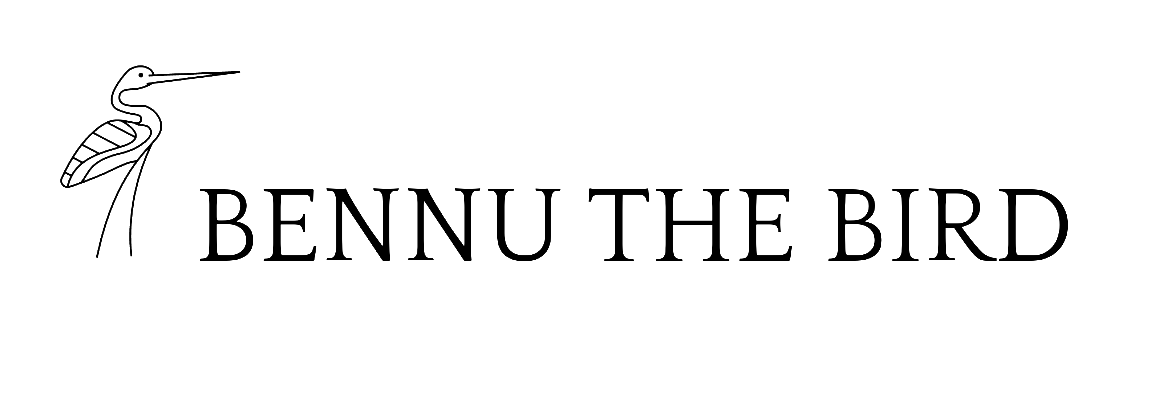Here you'll find the answer to what Bennu The Bird stands for, where the name originates from and why it is important to you.
INTRO
I have chosen the name Bennu The Bird for a special reason. You might think “Oh, a bird and he writes about traveling. So, he flies around the world discovering places”. Although, this makes sense and I enjoy the connection with traveling. It is not the reason why.
BACKGROUND INFO
Bennu is a mythological bird resembling a heron that was worshipped in ancient Egypt for its powers of creation and resurrection. According to the mythology the bennu bird lived in the Tree of Life – also known as the Persea tree – in the ancient city Heliopolis.
This sacred bird came to be connected with three major Egyptian deities: Atum, Ra and Osiris.
Ancient Egyptian religion states that life came forth out of the Waters of Nun, a primordial oceanic abyss out of which the god Atum created himself. It is said that the bennu flew over these waters and that its cry broke the primeval silence and marked the beginning of time.
Furthermore, the Egyptians believed that this bird represented the ba – one of the three parts of the soul – of the sun god Ra. Accordingly, the bennu served as a symbol for the rising and the setting of the sun. Fun fact: the name ‘bennu’ is derived from the Egyptian verb ‘weben’, which means ‘to rise’ or ‘shine’.
As for the last deity, bennu was also considered a manifestation of the resurrection of Osiris, the Egyptian Lord of the Underworld.
WHAT DOES THIS MEAN?
Now, all of this might not ring a bell, but I am confident many of you are familiar with the Western version. It is said that the Greeks were intrigued by this deity, incorporated it and renamed it as the phoenix. The solar bird that sets itself on fire and obtains new life by rising out of its own ashes. In short, the phoenix or the bennu bird reflects the idea that something new is created out of the destruction of the older version. For example, you drop a bad habit (smoking) and take on a beneficial one (sporting). This concept of creative destruction is what my blog stands for. It is very personal and can be interpreted in many different ways. But for me, it serves as a reminder to keep moving forward. Not literally, but on a personal level. It is about reinventing yourself and advancing your mindset. Destroy and create. Dare to endeavor into new projects and learn new skills. It is about seeking wisdom and acquiring knowledge. It’s about waking up and seizing the day. There is a lot of noise – read: bullshit – in this world and I’m on a quest for the signals. What’s important and has meaning to me.
Above stands the message the bennu bird carries with him. Now it is up to you to decide what you are willing to destroy in order to create something new and better.
You must wish to consume yourself in your own flame. How could you wish to become new unless you had first become ashes! – Nietzsche
WHY I CHOSE BENNU
I stumbled upon the notion of creative destruction while doing research for my journalism thesis at university. At that time starting a blog was not something I was thinking about. Later on, while I was backpacking through India and brainstorming about a blog, the symbolism of the bennu came back to me. It seemed like a perfect fit. Not only because it reflected my state of mind, but also because I wanted a name that represented a meaningful and universal concept. I did not want my name to be exclusively limited to traveling.
Furthermore, it reflects a personal principle that doesn’t hurt reminding myself of every chance I get.

India is the birthplace of my blog. It is the land where Bennu The Bird was conceived and put into practice. It just so happens that Hinduism, the dominant religion in India, is a prime example of creative destruction. Hinduism is quite complex and many different communities have different approaches and interpretations of the Indian pantheon. But generally, the Hindus recognise three supreme gods. There is Brahma who creates the universe, Vishnu who preserves and protects it, and Shiva who destroys the universe. After the destruction of Shiva, the cycle of life restarts when Brahma begins the creation. It is an infinite loop of creative destruction.
In other traditions, Shiva is worshipped as both the creator and the destroyer. Following this perspective, he is depicted as the Lord of the Dance. The Dance being a representation of destroying and rebuilding the universe.
To conclude, a poem by the Indian artist Rabindranath Tagore:
‘From the heart of all matter
Comes the anguished cry
‘Wake, wake, great Siva, Our body grows weary
Of its law-fixed path,
Give us new form.
Sing our destruction,
That we gain new life’

